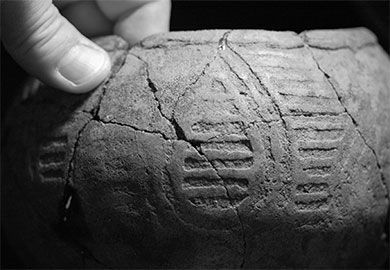August 14, 2019

A collaborative project between SCDNR Heritage Trust
program archaeologists
and University of South Carolina
computer scientists has enormous
potential to help
researchers better understand the artifacts left
by Native American civilizations in South Carolina and elsewhere.
The National Endowment for the Humanities recently awarded a $320,000, two-year grant to support a collaborative project between the South Carolina Heritage Trust Program and the University of South Carolina. The project, “SnowVision: A Machine Learning-Based Image Processing Tool for the Study of Cultural Heritage Collections,” will facilitate the expansion and extension of a set of tools designed to assist scholars with identifying and classifying design motifs on artifacts.
“This is an incredibly impressive grant,” said Ken Rentiers, deputy director for the Land, Water and Conservation Division of the South Carolina Department of Natural Resources (SCDNR), of which the Heritage Trust Program is a part. “This collaborative project has the potential to impact Native American research across a two-thousand-year period.”
SnowVision software is in its fourth year of development and represents an exciting collaboration between archaeologists and University of South Carolina computer vision scientists, high performance computing specialists, and digital humanities scholars.
Dr. Karen Y. Smith, Heritage Trust archaeologist, is the project director. Smith said the main goal of the Digital Humanities Advancement grant is to place SnowVision into the hands of scholars and other stakeholders working in laboratories, museums, and classrooms across the Southeast. For instance, NEH funding allows the project team to acquire and integrate feedback from a fifteen-member advisory committee and supports five university-based satellite labs, where the project aims to expand digitization efforts.
SnowVision assists researchers in the study of paddle-stamped motifs on pottery that dates from AD 1-800. Smith said some 1,820 archaeological sites with such pottery have been recorded across the present-day states of Alabama, Florida, Georgia and South Carolina. Hundreds of thousands of pottery sherds from these sites reside in curation facilities and laboratories. Before, making sense of these large and scattered collections was a daunting task for researchers. Machine-learning-based, design-matching algorithms offered by SnowVision software will help archaeologists and other scientists analyze and begin to understand these collections, according to Smith.
SnowVision will be co-funded by NEH’s Office of Digital Humanities and NEH’s Division of Research. Created in 1965 as an independent federal agency, the NEH supports research and learning in history, literature, philosophy, and other areas of the humanities by funding selected, peer-reviewed proposals from around the nation. Additional information about the National Endowment for the Humanities and its grant programs is available at: www.neh.gov.
Since 1974, SCDNR’s Heritage Trust Program has preserved and protected natural and cultural properties across South Carolina. For more information about the SCDNR Heritage Trust Program, please visit http://heritagetrust.dnr.sc.gov/. Additional information about SnowVision is available at: https://sc.edu/about/centers/digital_humanities/projects/snowvision.php.
Media Contact: David Lucas, Regional Public Information Coordinator 843-610-0096.



